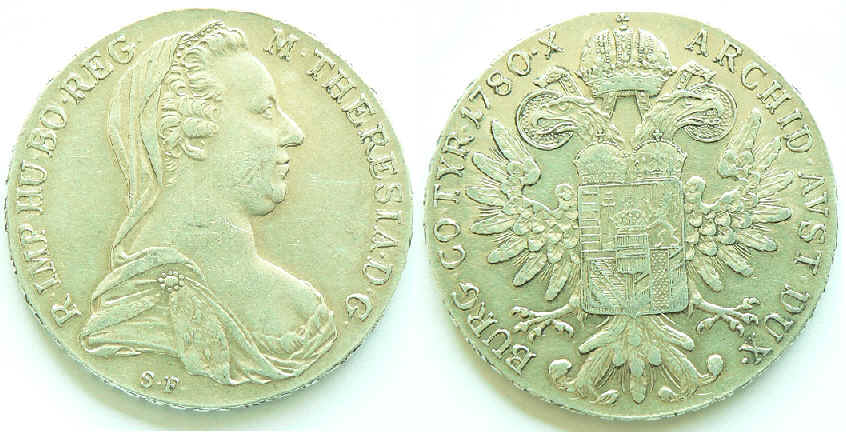

| Type munt | Maria Theresia daalder | Omschrift voorzijde | M. THERESIA D. G. R. IMP. HU. BO. REG. Maria Theresia, Dei Gratia Romanorum Imperatrix, Hungariae Bohemiaeque Regina, Maria Theresa, by the grace of God, Empress of the Romans, Queen of Hungary and Bohemia |
Muntconditie | zeer fraai |
| Land | Oostenrijk | Omschrift keerzijde | ARCHID. AVST. DUX BURG. CO. TYR. 1780 X Archidux Austriae, Dux Burgundiae, Comes Tyrolis. 1780 X", Archduchess of Austria, Duchess of Burgundy, Countess of Tyrol. 1780 The "X" is actually a saltire, and was added after 1750 denoting Maria Theresa's reign over the Austrian Netherlands. |
Datum | april 2011 |
| Muntplaats | Voorzijde | buste Maria Theresia naar links | Verkoper | ||
| Jaartal | 1780 | Keerzijde | gekroond wapen | Bedrag | euro 29 |
| Vorst | Vindplaats | Veiling | Filanumis Houten | ||
| Metaal | zilver (0,752) | Schatvondst | |||
| Oplage | Literatuur referentie | ||||
| Gewicht | 27,99 gram | ||||
| Diameter | 41,15 mm | ||||
| Soortelijke massa |
From Wikipedia, the free encyclopedia The Maria Theresa thaler (MTT) is a silver bullion-coin that has been used in world trade continuously since it was first minted in 1751. It was named after Empress Maria Theresa, who ruled Austria, Hungary, and Bohemia from 1740 to 1780. Since 1780, the coin has always been dated 1780. On September 19, 1857, Emperor Francis Joseph of Austria declared the Maria Theresa Taler to be an official trade coinage. A little over a year later, on October 31, 1858, the Maria Theresa Taler lost its status as currency in Austria. The following mints have struck MTTs: Birmingham, Bombay, Brussels, London, Paris, Rome and Utrecht, in addition to the Habsburg mints in GŁnzburg, Hall, Karlsburg, Kremnica, Milan, Prague and Vienna. Between 1751 and 2000, some 389 million were minted. These different mints distinguished their issues by slight alterations to the saltire, or flower symbol, which looks like an X, at the top left of the reverse side of the coin. In 1946, the Vienna Mint rescinded any rights of foreign governments to issue such copies; subsequently, the Vienna Mint has produced over 49 million MTTs. The MTT "began being minted in 1751 and formed a considerable portion of American currency after that date."[1] It was one of the first coins used in the United States and probably contributed, along with the Spanish dollar, to the choice of a dollar as the main unit of currency for the United States.[citation needed] The MTT came to be used as currency in large parts of Africa until after World War II. It was common from North Africa to Somalia, Ethiopia, Kenya, and down the coast of Tanzania to Mozambique. Its popularity in the Red Sea region as such that merchants would not accept any other type of currency. The Italian government produced a similar designed coin in the hope of replacing the Maria Theresa thaler, but it was rejected.[2] It could also be found throughout the Arab world, especially in Saudi Arabia, Yemen and Muscat and Oman, and in India. During the Japanese occupation of Indonesia in World War II, enough people preferred it to the money issued by the occupying forces that the American Office of Strategic Services created counterfeit MTTs for use by resistance forces.[3] In German-speaking countries, following a spelling reform dated 1901 which took effect two years later, "Thaler" is written "Taler" (although the spelling of "Theresia" was not affected because of Greek origin). Hence 20th-century references to this coin in German and Austrian sources are found under "Maria-Theresien-Taler". The spelling in English-speaking countries was not affected. The thaler is 39.5 mm in diameter and 2.5mm thick, weighs 28.0668 grams and contains 23.3890 grams (0.752 troy ounces) of fine silver. Around the rim of the coin is the motto of her reign: "Justitia et Clementia", meaning "Justice and Clemency". |